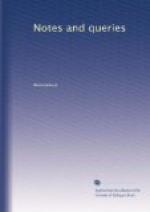{330} a folio book on Orders of Knighthood, and, giving
to many of them an antiquity of several centuries,—often
either fabulous or greatly exaggerated,—provided
them all with imaginary collars, of which he exhibits
engravings. M. Favyn’s book was republished
in English, and his collars have been handed down
from that time to this, in all our heraldic picture-books.
This is one important warning which it is necessary
to give any one who undertakes to investigate this
question. From my own experience of the difficulty
with which the mind is gradually disengaged from preconceived
and prevailing notions on such points, which it has
originally adopted as admitting of no question, I
know it is necessary to provide that others should
not view my arguments through a different medium to
myself. And I cannot state too distinctly, even
if I incur more than one repetition, that the Collar
of Esses was not a badge of knighthood nor a badge
of personal merit; but it was a collar of livery; and
the idea typified by livery was feudal dependence,
or what we now call party. The earliest livery
collar I have traced is the French order of cosses
de geneste, or broomcods: and the term “order”,
I beg to explain, is in its primary sense exactly
equivalent to “livery:” it was used
in France in that sense before it came to be
applied to orders of knighthood. Whether there
was any other collar of livery in France, or in other
countries of Europe, I have not hitherto ascertained;
but I think it highly probable that there was.
In England we have some slight glimpses of various
collars, on which it would be too long here to enter;
and it is enough to say, that there were only two
of the king’s livery, the Collar of Esses and
the Collar of Roses and Suns. The former was
the collar of our Lancastrian kings, the latter of
those of the house of York. The Collar of Roses
and Suns had appendages of the heraldic design which
was then called “the king’s beast,”
which with Edward IV. was the white lion of March,
and with Richard III. the white boar. When Henry
VII. resumed the Lancastrian Collar of Esses, he added
to it the portcullis of Beaufort. In the former
Lancastrian regions it had no pendant, except a plain
or jewelled ring, usually of the trefoil form.
All the pendant badges which I have enumerated belong
to secular heraldry, as do the roses and suns which
form the Yorkist collar. The letter S is an emblem
of a somewhat different kind; and, as it proves, more
difficult to bring to a satisfactory solution than
the symbols of heraldic blazon. As an initial
it will bear many interpretations—it may
be said, an indefinite number, for every new Oedipus
has some fresh conjecture to propose. And this
brings me to render the account required by Dr. Rock
of the reasons which led me to conclude that the letter
S originated with the office of Seneschallus or Steward.
I must still refer to the Gentleman’s Magazine
for 1842, or to the republication of my essays which




